How can I eat sustainable food?
The way we eat is simply untenable, for the climate and for the earth and for us. But what can we do?
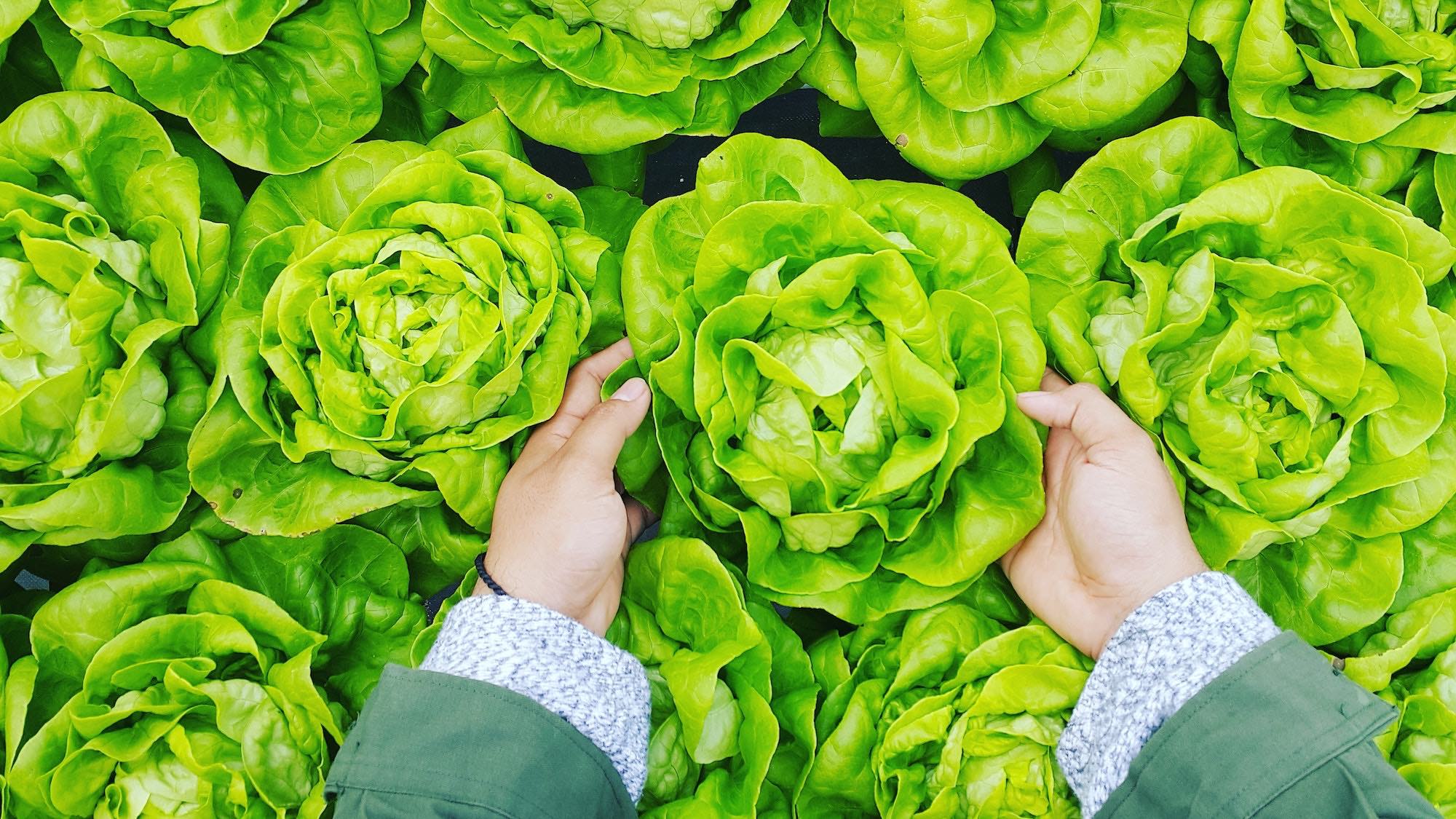
Farms may seem old fashioned, but these days they're very high-tech, equipped with GPS-equipped tractors and seeds engineered to maximize yields and chemicals intended to keep away pests and weeds.
These technologies have helped us boost the amount of food we have to feed the world—but at a steep cost. More than a quarter of global greenhouse gas emissions come out of our food system, one of its many environmental impacts.
The Food and Agriculture Organization of the United Nations defines a sustainable food system as one that provides both profits and broad benefits to society, while also having a positive—or at least neutral—impact on the environment. Is it possible to accomplish all of this at once? It turns out to be difficult, though there are proactive steps you as a consumer can take.
📚 Jump to section:
What are the environmental impacts of our food system?
Let's start with the climate: A full quarter of global greenhouse emissions come from food production. Fossil fuels are used to power tractors and other farm equipment, as well as the vehicles that carry the harvest to market. The use of nitrogen-based fertilizers releases N2O, a potent greenhouse gas. (Over the past four decades, the rate of human N2O emissions has increased 30%.) Forests are cleared to plant new farms, decreasing rates of carbon storage.
One of the biggest climate problems is ruminants. This set of mammals—which includes cows and goats and lambs—has evolved a specialized stomach that helps to ferment and break down grasses. That process that also releases methane, a greenhouse gas. Ruminants literally burp out problematic gases.
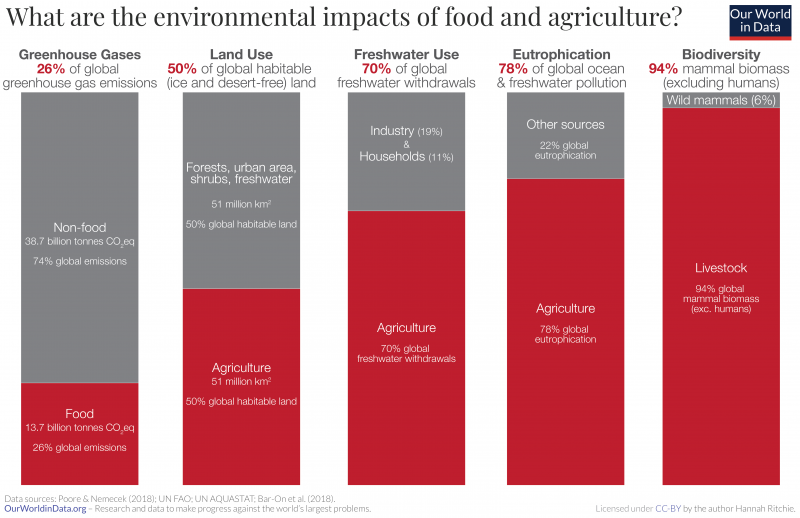
Unfortunately, climate change is the not the only environmental challenge. There are freshwater problems: Seventy percent of global freshwater withdrawals are for the sake of agriculture. There are ocean problems: Fertilizers cause eutrophication, caused by rain carrying these chemicals into waterways. There, they feed algae, which bloom so extensively that they begin to block out other forms of life. There are land-surface problems: Farming is a prime driver of habitat loss. At this point, the biomass of our livestock exceeds that of wild mammals by a ratio of 15 to 1.
Climate change is not the only environmental problem associated with our food system—and the other problems are just as pressing.
Scientists have developed a list of nine "planetary boundaries," a set of guard rails intended to keep us from causing large-scale collapses of ecosystems and economies. We've already crossed three boundaries: for climate change, for the biogeochemical flow of nitrogen, and for biodiversity. The food system can be implicated in all three.
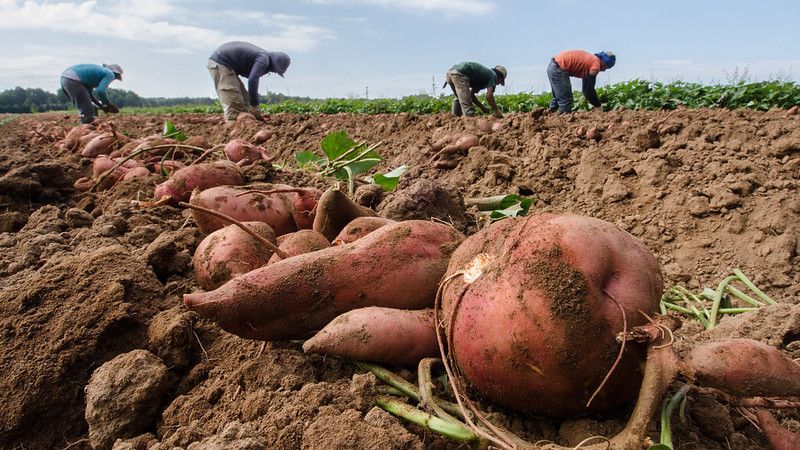
And remember that sustainability is not just about nature, but about human communities, too. There are real concerns about the labor system on some big, industrialized farms.
So what should I eat, then?
When it comes to picking and choosing ingredients, it's easiest, really, to focus on what you might avoid.
Meat in general has a much bigger emissions impact than plants—10 and 50 times greater, in general. That's because animals eat plants, so whatever emissions come from growing vegetables are repeated as we grow feed for livestock—on an even bigger scale, since livestock need to eat a lot of plants to build up their bulk.
Meat consumption also puts pressure on biodiversity. The meat industry simply takes up a lot of space: 77% of global farmland is devoted to growing livestock, which contribute only 18% of the world's calories.

The most problematic meat is beef. Cows are ruminants, so they directly emit methane into the atmosphere—and they are worse than other ruminants because they take longer to grow to market size. By weight, beef is also among the biggest contributors to eutrophication in the food system. The majority of the nitrogen in the grains fed to cattle pass right through their digestive system and wind up back on the ground, where they are carried into rivers and oceans.
Another no-go are farmed prawns. The system used to grow prawns soaks up huge amounts of fresh water. Large-scale aquaculture also has an emissions problem, due to methane released by other sea creatures who consume excess fish feed. (Further, mangrove swamps are often cleared for fish farms, which destroys a carbon sink.)
Other foods to consider avoiding: dairy, since it's generally produced by ruminants, also has a substantial impact. Nuts have a high water footprint, almonds especially. (But—just to show how complicated the calculus gets—nuts can actually be carbon negative, since the tree and its carbon remain in place as the nuts are harvested.) Coffee is a major contributor to eutrophication.
Of course, sustainable eating is not just about which foods you eat. Where you buy your foods matters, as does what you do with it. Consider food waste: it contributes to a full 6% of global greenhouse emissions. Buying only what you need is an important first step towards sustainability.
What role does eating locally play?
An increasingly popular choice is eating "locally": seeking farms and food sources that are located near one's home. When it comes to climate change, this doesn't solve much, sadly. Almost all the research shows that food transportation makes up a small slice of emissions. Most food is carried by rail or is shipped by boat—both of which are fairly efficient. In some cases, the impact of trucking produce a few hundred miles could be worse than sending it across an ocean. (Small local farms may have lower yields, too, which means per unit of food their emissions may be higher.)
Transportation is a much bigger issue when it comes to food that is flown. As a rule of thumb, anything that can be stored for a few weeks was probably shipped; but unless you live near the farm, perishable fruits like berries are likely to have arrived by air.
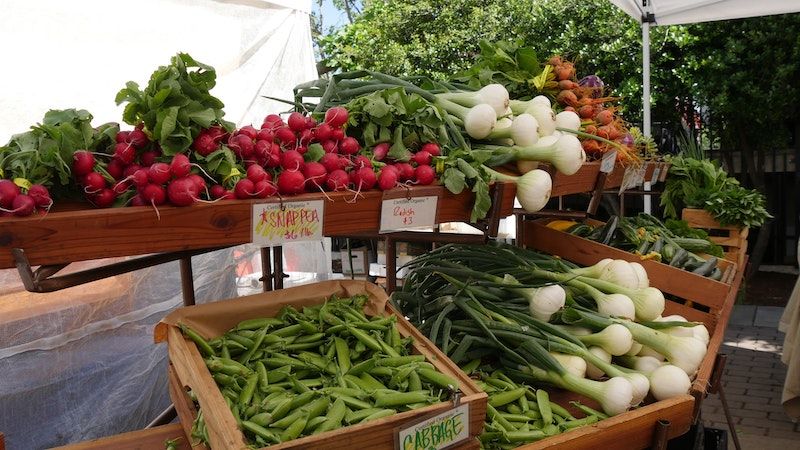
Again, though, climate is not the only factor in the equation. The clearest benefit of buying locally goes to the economy: This practice keeps money local, creating jobs and sustaining a community.
What about farming practices?
Another benefit of shopping locally is that it becomes easier to understand the practices used on the farm. And this matters. The climate impact of any specific product can hugely vary, depending on how it's grown. Eating beef from a cow that first produced milk can reduce the carbon impact by 60%, for example, since emissions are shared across products. Spreading a substance called biochar across soils can assist in both carbon storage and water retention.
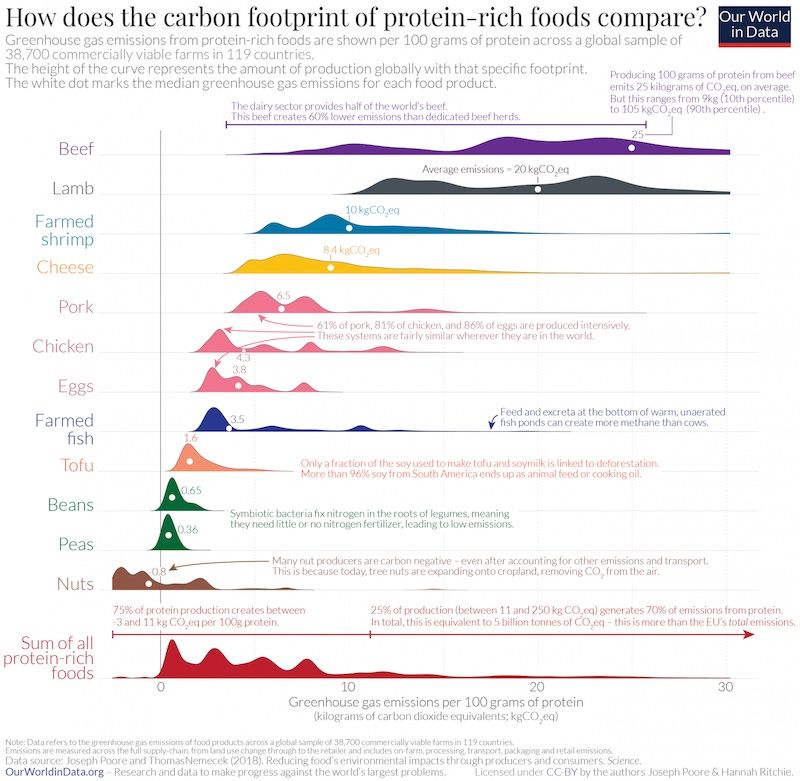
But even the choice of how to farm can get tangled, given the various environmental impacts of farming. Feeding cows grass rather than grain can reduce rates of eutrophication. But it also means more methane is released, because the cows grow at a slower rate. (One of the primary arguments for eating grass-fed beef is not the environment, but animal welfare; grass is the food that cows evolved to eat, and so they tend to be healthier on such a diet.) Some choices are constrained by how the industry chooses to operate. For example, strange as it sounds, recycling urine to use as fertilizer could decrease farm carbon footprints, given the intense process currently required to produce fertilizers. So far, though, this has not caught on commercially.
Crop yields, too, are complicated: Generally, the higher the yield per plant, the better for the climate and for biodiversity. Since more food is being produced on the same amount of land, there is less pressures on forests. But high-yield farming often involves intensive use of chemicals, which is part of why the nitrogen fertilizer use has increased eight-fold over the past sixty years.
There is no silver bullet. What works on one farm may not work on another. How to distribute food fairly must be considered, too.
Adding to the headache is the way our food system is distributed across the world. Some people have more than enough food; meanwhile, more than 800 billion people go undernourished. A sustainable global food system is not just one that protects the environment, but one that feeds all of humanity. High-tech, industrialized agriculture does increase yields; but when such technology arrives in developing nations, it often means that food production is taken out of local communities' hands and put into the hands of large corporations. Critics believe this actually decreases food security and winds up leaving many people hungry, unable to afford the new crops.
There is simply no silver bullet, no one practice that will solve all problems. What works on one farm may not work on another because of differing geography. To solve the systemic issues within the food industry will likely require us to weave together both new innovations and age-old practices.
What is the potential impact of a global shift in diet?
There will have to be a global shift in dietary practices if we are going to address the climate crisis. There is simply no way to reduce emissions sufficiently without cutting back on beef and lamb.
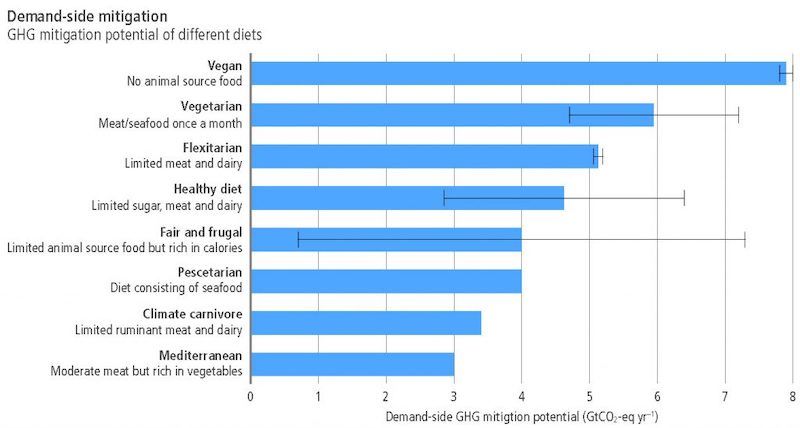
The Intergovernmental Panel on Climate Change analyzed various diets and found that a vegan diet offered the greatest global impact. If everyone cut out animal-sourced food, emissions might drop by 8 million tonnes of CO2e. Much of the savings is due to decreased land use: A veggie-centric diet could allow us to feed more people while using less land. (We'd be healthier on average, too.) Even without giving up meat entirely, there would still be massive impacts if everyone ate meat only once per month.
In the U.S., one of the world's most beef-loving nations, consumption has already begun to fall. There is a long way to go, though, and it isn't entirely clear how we might push this further. Meat taxes? Labels that clearly indicate the carbon footprint of foods? Perhaps just rearranging grocery stores to subtly prompt people to buy lighter-footprint foods? One way or another, though, a major shift is needed. Everyone who opts out of meat is helping set the tone for what the new normal might be.

